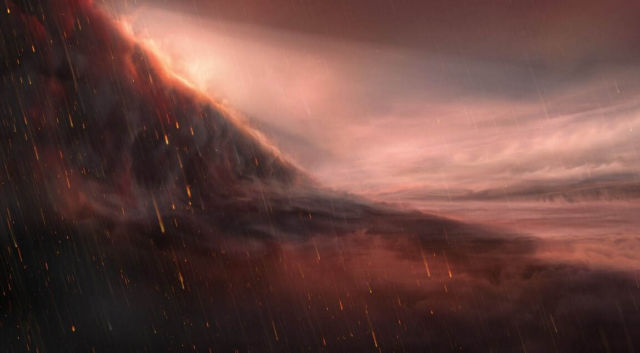ESO Telescope observes an exoplanet where temperatures climb above 2400 degrees Celsius and could rain iron.
Scientists using ESO’s Very Large Telescope (VLT) have observed an extreme planet where they suspect it rains iron. The ultra-hot giant exoplanet has a day side where temperatures climb above 2400 degrees Celsius, high enough to vaporise metals. Strong winds carry iron vapour to the cooler night side where it condenses into iron droplets.
“One could say that this planet gets rainy in the evening, except it rains iron,” says David Ehrenreich, a professor at the University of Geneva in Switzerland. He led a study, published today in the journal Nature, of this exotic exoplanet. Known as WASP-76b, it is located some 640 light-years away in the constellation of Pisces.
This strange phenomenon happens because the ‘iron rain’ planet only ever shows one face, its day side, to its parent star, its cooler night side remaining in perpetual darkness. Like the Moon on its orbit around the Earth, WASP-76b is ‘tidally locked’: it takes as long to rotate around its axis as it does to go around the star.
On its day side, it receives thousands of times more radiation from its parent star than the Earth does from the Sun. It’s so hot that molecules separate into atoms, and metals like iron evaporate into the atmosphere. The extreme temperature difference between the day and night sides results in vigorous winds that bring the iron vapour from the ultra-hot day side to the cooler night side, where temperatures decrease to around 1500 degrees Celsius.
Not only does WASP-76b have different day-night temperatures, it also has distinct day-night chemistry, according to the new study. Using the new ESPRESSO instrument on ESO’s VLT in the Chilean Atacama Desert, the astronomers identified for the first time chemical variations on an ultra-hot gas giant planet. They detected a strong signature of iron vapour at the evening border that separates the planet’s day side from its night side. “Surprisingly, however, we do not see the iron vapour in the morning,” says Ehrenreich. The reason, he says, is that “it is raining iron on the night side of this extreme exoplanet.”
“The observations show that iron vapour is abundant in the atmosphere of the hot day side of WASP-76b,” adds María Rosa Zapatero Osorio, an astrophysicist at the Centre for Astrobiology in Madrid, Spain, and the chair of the ESPRESSO science team. “A fraction of this iron is injected into the night side owing to the planet’s rotation and atmospheric winds. There, the iron encounters much cooler environments, condenses and rains down.”
source ESO






Leave A Comment